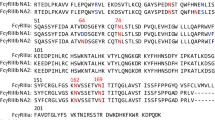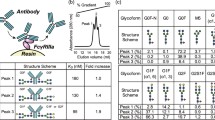Abstract
Three anti-carbohydrate antibodies of defined specificity isolated from plasma were used to demonstrate that macromolecular antigen binding caused considerable enhancement of fluorescence of FITC-labeled antibody. Mono and disaccharide antigens which could compete with the large antigens in antibody binding could not however produce any increase in fluorescence. Fluorescence enhancement in a given antibody sample increased with the size of the occupying macromolecular antigen. Conversely in antibody samples of same ligand specificity isolated from plasma of different individuals, fluorescence enhancement produced by the same antigen correlated with specific activity of the antibody sample. Removal of Fc part of antibody, confirmed by electrophoresis and Fc-specific antibody binding, caused abolition of most of the antigen-driven fluorescence increase. Since antigen binding sites of antibodies were protected during FITC labeling, the above results suggest that conformational shift in Fc produced by occupation of binding sites by large antigens resulted in the enhancement of fluorescence of FITC tags on Fc. Data provides a tool for detection and measurement of specific ligands using fluorolabeled whole antibodies.






Similar content being viewed by others
References
Schlessinger J, Steinberg IZ, Givol D et al (1975) Antigen-induced conformational changes in antibodies and their fab fragments studied by circular polarization of fluorescence. Proc Natl Acad Sci 72:2775–2779. doi:10.1073/pnas.72.7.2775
Kuby J, Kindt TJ, Goldsby RA, Osborne BA (2007) Immunology, 6th edn. 5. pr. W.H. Freeman & Co., New York
Brown JC, Koshland ME (1975) Activation of antibody Fc function by antigen-induced conformational changes. Proc Natl Acad Sci U S A 72:5111–5115. doi:10.1073/pnas.72.12.5111
Berger C, Weber-Bornhauser S, Eggenberger J et al (1999) Antigen recognition by conformational selection. FEBS Lett 450:149–153. doi:10.1016/S0014-5793(99)00458-5
Stanfield RL, Wilson IA (1994) Antigen-induced conformational changes in antibodies: a problem for structural prediction and design. Trends Biotechnol 12:275–279. doi:10.1016/0167-7799(94)90139-2
Davies DR, Cohen GH (1996) Interactions of protein antigens with antibodies. Proc Natl Acad Sci 93:7–12. doi:10.1073/pnas.93.1.7
Oda M (2003) Evidence of allosteric conformational changes in the antibody constant region upon antigen binding. Int Immunol 15:417–426. doi:10.1093/intimm/dxg036
Keskin O (2007) Binding induced conformational changes of proteins correlate with their intrinsic fluctuations: a case study of antibodies. BMC Struct Biol 7:31. doi:10.1186/1472-6807-7-31
Abe R, Ohashi H, Iijima I et al (2011) “Quenchbodies”: quench-based antibody probes that show antigen-dependent fluorescence. J Am Chem Soc 133:17386–17394. doi:10.1021/ja205925j
Geetha M, Kalaivani V, Sabarinath PS, Appukuttan PS (2014) Plasma anti-α-galactoside antibody binds to serine- and threonine-rich peptide sequence of apo (a) subunit in Lp (a). Glycoconj J 31:289–298. doi:10.1007/s10719-014-9521-2
Jaison PL, Kannan VM, Geetha M, Appukuttan PS (1993) Epitopes recognized by serum anti-α-galactoside antibody are present on brain glycoproteins in man. J Biosci 18:187–193. doi:10.1007/BF02703115
Paul A, Geetha M, Chacko BK, Appukuttan PS (2009) Multiple specificity of human serum dextran-binding immunoglobulin: α (1 → 6)- and β (1 → 3)-linked glucose and α (1 → 3)-linked galactose in natural glycoconjugates are recognized. Immunol Investig 38:153–164. doi:10.1080/08820130902729629
Geetha M, Annamma KI, Mathai J, Appukuttan PS (2007) Normal human plasma anti-beta-glucoside antibody has markedly elevated IgA content and binds fungal and yeast polysaccharides. Immunol Investig 36:73–83. doi:10.1080/08820130600745737
Hudson L, Hay FC (1980) Practical immunology, 2nd edn. Blackwell, Oxford
Appukuttan PS, Surolia A, Bachawat BK (1977) Isolation of two galactose-binding proteins from ricinus communis by affinity chromatography. Indian J Biochem Biophys 14:382–384
Baues RJ, Gray GR (1977) Lectin purification on affinity columns containing reductively aminated disaccharides. J Biol Chem 252:57–60
Heyderman E, Strudly K, Richardson TC (1986) Immunohistochemistry in pathology. In: Weir DM (ed) Handbook of experimental immunology. Blackwell Scientific Publications, Oxford, Boston
Bradford MM (1976) A rapid and sensitive method for the quantitation of microgram quantities of protein utilizing the principle of protein-dye binding. Anal Biochem 72:248–254. doi:10.1016/0003-2697(76)90527-3
DuBois M, Gilles KA, Hamilton JK et al (1956) Colorimetric method for determination of sugars and related substances. Anal Chem 28:350–356. doi:10.1021/ac60111a017
Travis J, Bowen J, Tewksbury D et al (1976) Isolation of albumin from whole human plasma and fractionation of albumin-depleted plasma. Biochem J 157:301–306
Sela-Culang I, Alon S, Ofran Y (2012) A systematic comparison of free and bound antibodies reveals binding-related conformational changes. J Immunol 189:4890–4899. doi:10.4049/jimmunol.1201493
Connell GE, Porter RR (1971) A new enzymic fragment (Facb) of rabbit immunoglobulin G. Biochem J 124:53P
Kabat EA (1960) The upper limit for the size of the human antidextran combining site. J Immunol Baltim Md 84:82–85
Galili U, Clark MR, Shohet SB et al (1987) Evolutionary relationship between the natural anti-Gal antibody and the Gal alpha 1–3 Gal epitope in primates. Proc Natl Acad Sci 84:1369–1373. doi:10.1073/pnas.84.5.1369
Cohen BE, Pralle A, Yao X et al (2005) A fluorescent probe designed for studying protein conformational change. Proc Natl Acad Sci 102:965–970. doi:10.1073/pnas.0409469102
Abe R, Jeong H-J, Arakawa D et al (2014) Ultra Q-bodies: quench-based antibody probes that utilize dye-dye interactions with enhanced antigen-dependent fluorescence. Sci Rep. doi:10.1038/srep04640
Semisotnov GV, Rodionova NA, Razgulyaev OI et al (1991) Study of the “molten globule” intermediate state in protein folding by a hydrophobic fluorescent probe. Biopolymers 31:119–128. doi:10.1002/bip.360310111
Kusumi A, Winkelhake JL (1986) Fc: Fc interactions revealed by spin-labeled IgG heterosaccharides in model immune complexes. Biochem Biophys Res Commun 137:237–243. doi:10.1016/0006-291X(86)91201-5
Gaboriaud C, Juanhuix J, Gruez A et al (2003) The crystal structure of the globular head of complement protein C1q provides a basis for its versatile recognition properties. J Biol Chem 278:46974–46982. doi:10.1074/jbc.M307764200
Springer GF, Horton RE (1969) Blood group isoantibody stimulation in man by feeding blood group-active bacteria. J Clin Invest 48:1280–1291. doi:10.1172/JCI106094
Paul A, Antony M, Mathai J, Appukuttan PS (2011) High polymeric IgA content facilitates recognition of microbial polysaccharide-natural serum antibody immune complexes by immobilized human galectin-1. Immunol Lett 136:55–60. doi:10.1016/j.imlet.2010.12.004
Acknowledgments
Genu George was awarded a fellowship by CSIR, Government of India. Authors are grateful to Ms. Sumitha. K. C for technical assistance and to the Department of Transfusion Medicine of this institute for supply of out-dated plasma.
Conflict of Interest
None
Author information
Authors and Affiliations
Corresponding author
Rights and permissions
About this article
Cite this article
George, G., Geetha, M. & Appukuttan, P.S. Antigen-Induced Activation of Antibody Measured by Fluorescence Enhancement of FITC Label at Fc. J Fluoresc 25, 1493–1499 (2015). https://doi.org/10.1007/s10895-015-1640-z
Received:
Accepted:
Published:
Issue Date:
DOI: https://doi.org/10.1007/s10895-015-1640-z




